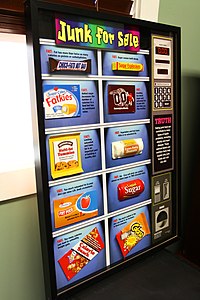垃圾食品
含有较高来自糖或脂肪的卡路里,可能还有大量的钠,但几乎没有膳食纤维、蛋白质、维生素、矿物质或其他重要形式的营养的食物
垃圾食品(英語:Junk Food)通常描述含有較高的來自糖或脂肪的卡路里,並可能還有大量的鈉,但幾乎沒有膳食纖維、蛋白質、維生素、礦物質或其他重要形式的營養的食物[1][2][3],其也被稱為HFSS食品(英語:HFSS Food),即高脂、高鹽、高糖(High in Fat, Salt and Sugar)的食品[4]。「垃圾食品」被用於貶義的歷史可追溯至1950年代[5]。


垃圾食品一詞的精確定義因目的和時間而異。 一些高蛋白食物,如用飽和脂肪製成的肉類,也可能被視為垃圾食品[6]。快餐和快餐店常被與垃圾食品劃上等號,儘管快餐不能被斷然描述為垃圾食品[7][8][9]。大多數垃圾食品是高度加工的食品。
對飲食過多垃圾食品造成的健康負面影響(尤其是肥胖)的擔憂已引發公眾健康宣傳運動,垃圾食品也在一些國家被限制廣告和銷售[10][11][12]。
參考資料
編輯- ^ junk food. Merriam-Webster Dictionary. [2015-03-13]. (原始內容存檔於2015-09-30).
- ^ junk food. Macmillan Dictionary. [2015-03-13]. (原始內容存檔於2015-04-02).
- ^ O'Neill, Brendon. Is this what you call junk food?. BBC News. 2006-11-30 [2010-06-29]. (原始內容存檔於2019-10-10).
- ^ Parks, Troy. WHO warns on kids' digital exposure to junk-food ads. American Medical Association. 2016-12-16 [2022-08-02]. (原始內容存檔於2022-02-05).
- ^ Zimmer, Ben. On Language: Junk. New York Times. 2010-12-30 [2015-03-19]. (原始內容存檔於2022-06-19).
- ^ Scott, Caitlin. Sustainably Sourced Junk Food? Big Food and the Challenge of Sustainable Diets. Global Environmental Politics. 2018-05, 18 (2): 93–113. ISSN 1526-3800. S2CID 57559050. doi:10.1162/glep_a_00458 (英語).
- ^ Smith, Andrew F. Encyclopedia of Junk Food and Fast Food. Greenwood Press. 2000-09-05: x. ISBN 978-0313335273.
- ^ Specter, Michael. Freedom from Fries. New Yorker. 2015-11-02 [2019-01-01]. (原始內容存檔於2022-07-11).
- ^ Smith, Rene. Fast Food Facts. Science Kids. [2019-01-01]. (原始內容存檔於2022-08-02).
- ^ Food Marketing to Kids. Public Health Law Center (William Mitchell College of Law). 2010 [2015-03-13]. (原始內容存檔於2015-10-28).
- ^ Protecting children from the harmful effects of food and drink marketing. World Health Organization. 2014-09 [2015-03-13]. (原始內容存檔於2014-09-20).
- ^ Food Marketing in Other Countries (PDF). [2022-08-02]. (原始內容存檔 (PDF)於2016-03-03).